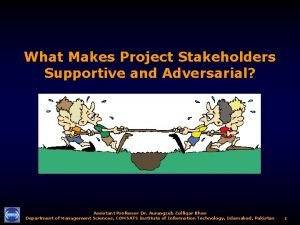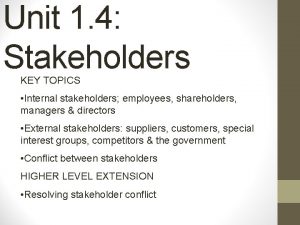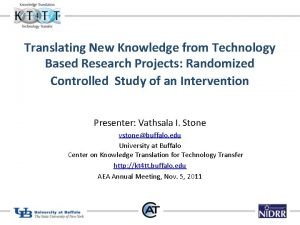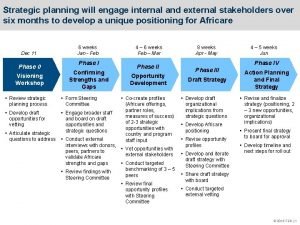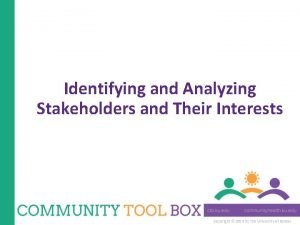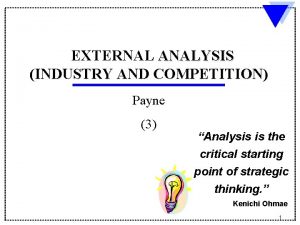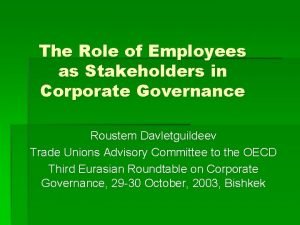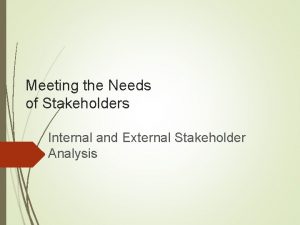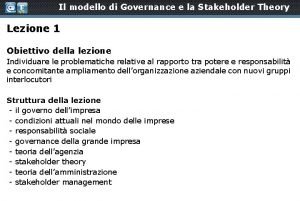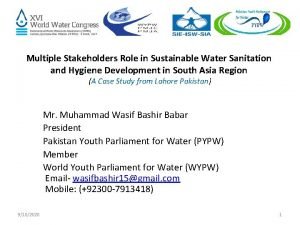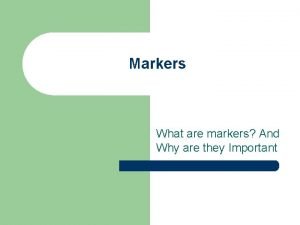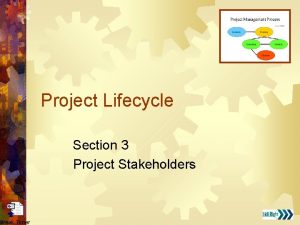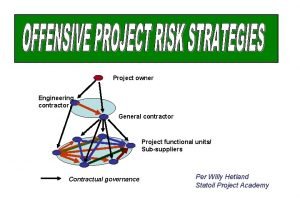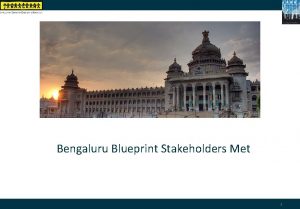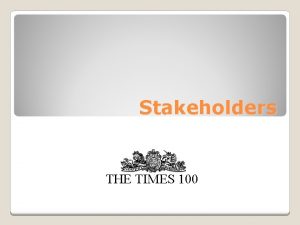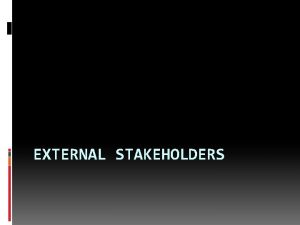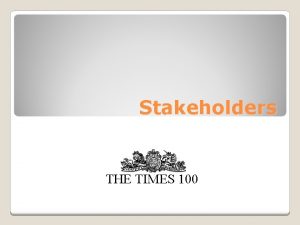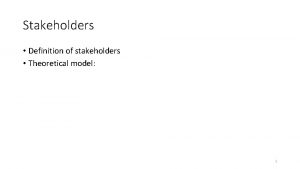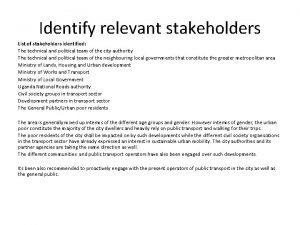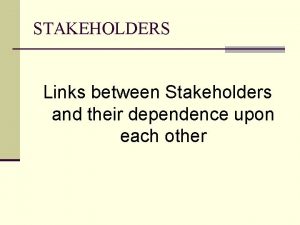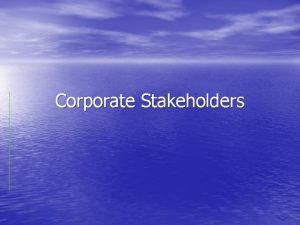Primary Stakeholders The Contractor The Project Contractor is
































- Slides: 32

Primary Stakeholders: The Contractor The Project Contractor is a key stakeholder who undertakes the bulk of physical work on civil engineering projects. Project Contractors often have to contend with many challenges and unforeseen problems in the course of project implementation! Some of the Contractor‘s major responsibilities include ensuring that the construction schedule as laid down in the project plan is kept, that the work undertaken is consistent with the project requirements and specifications and approved changes to the project scope are incorprated into the construction plan, that quality standards are not compromised, that laws and regulations are followed and licenses and permits from the authorities concerned are obtained, that construction progress is regularly monitored and communicated to the project team, that problems are resolved and a line of communication to other stakeholders is kept, and that close coordination with the Project Suppliers and Project Subcontractors is maintained. Assistant Professor Dr. Aurangzeb Zulfiqar Khan Department of Management Sciences, COMSATS Institute of Information Technology, Islamabad, Pakistan 1

Primary Stakeholders: The Supplier Like the Project Contractor, the Project Supplier is a key stakeholder in civil engineering and other categories of projects. Often, Suppliers have a network of Subsuppliers. The Project Supplier is the prime source of inputs which are used on large projects. The Supplier is responsible for ensuring that all the material inputs of the agreed specification and quality are delivered to the project site(s) in the required quantity at the time they are needed. This may be on a regular or periodic basis. The concept of „Just in Time“ (JIT) delivery by Suppliers has gained popularity in organizations in recent years, also for project managers as JIT brings some noteworthy benefits in the project management context. Delays in the supply of inputs to project sites may delay the project schedule. Hence, it is imperative that the Supplier closely coordinates with the Contractor, Project Manager and Project Team, especially during the project implementation phase. Assistant Professor Dr. Aurangzeb Zulfiqar Khan Department of Management Sciences, COMSATS Institute of Information Technology, Islamabad, Pakistan 2

Primary Stakeholders: The Consultant The Project Consultant can be an individual performing a few specialized tasks on a project – it can also be a organization which is concurrently working on several diverse projects and is involved in the project throughout its life-cycle. Project Consultants are indispensable for many projects. Consultants offer all kinds of services – for e. g. , undertaking pre-feasibility and feasibility studies, contract management, project planning, architectural and engineering design, cost estimation, scheduling, quality assurance, risk assessment, data management, monitoring, auditing, report evaluation, training (skill development, team building, communication etc. ), liaising with other project stakeholders and trouble-shooting. Consultants bring specialized expertise to the project and often have extensive project experience. Project consultancy is a challenging and innovative field of work. Assistant Professor Dr. Aurangzeb Zulfiqar Khan Department of Management Sciences, COMSATS Institute of Information Technology, Islamabad, Pakistan 3

Primary Stakeholders: The Project Customer The customer‘s responsibility is to clearly indicate to the project manager and team the needs and requirements that must be met by the project, review and approve the project charter and project plan, and closely interact with the project manager and team during the project‘s planning and implementation. The responsibility also lies with the customer to inform the project manager of any changes in the project environment that can or will effect the project deliverables, request and approve changes to the project when needed, provide regular feedback to the project manager, review project status reports and the final project status report, verify that the project scope has been completed according to agreement and evaluate the final project deliverables at the end of the project. Also called the “Project Owner”, the customer is the ultimate recipient of the project output or result. Customer satisfaction is a measure of the project’s success. Assistant Professor Dr. Aurangzeb Zulfiqar Khan Department of Management Sciences, COMSATS Institute of Information Technology, Islamabad, Pakistan 4

Secondary Stakeholders: Families Most families share similar desires – primarily to live in a comfortable, peaceful, clean, secure and child-friendly environment. However, projects which are being undertaken in close proximity to families often conflict to some extent therewith. Road and building construction projects, in particular, can be a source of considerable and enduring nuisance and inconvenience for families due to the noise, dust and dirt, pollution and the diversion of road traffic they cause. By comparison other projects - for example, the creation of playgrounds, parks, day care centers, sport and recreational facilities, nurseries and schools – would usually generate a higher level of interest and support among families who would probably count among their main users on completion. Families are very concerned about the impact of projects on them and their neighbourhoods. Assistant Professor Dr. Aurangzeb Zulfiqar Khan Department of Management Sciences, COMSATS Institute of Information Technology, Islamabad, Pakistan 5

Secondary Stakeholders: Tourists The tourist industry ranks for years amongst the fastest growing sectors of the global economy. People are taking to the roads and skies in ever increasing numbers to visit destinations within and beyond their national borders whereby their interests seem as varied as the places they visit. Tourists bring in immense sums of money and in many regions are the primal source of economic prosperity. Thousands of projects across the globe in countries as diverse as Egypt and Thailand, Turkey and the Maldive Islands, Spain and the UAE are being undertaken by governments and the private sector specifically to cater to the needs of tourists. Other projects – usually in the superlative category– can generate considerable interest among tourists as can projects to improve infrastructure and cultural facilities in towns, cities and localities. Tourists are a force to be reckoned with. There’s hardly a place on Earth they haven’t discovered. Assistant Professor Dr. Aurangzeb Zulfiqar Khan Department of Management Sciences, COMSATS Institute of Information Technology, Islamabad, Pakistan 6

Secondary Stakeholders: Media The media in its print, broadcast and web-based forms is a (very) powerful force. Through its news and event reporting, the media shapes public opinions. In the case of projects, the media has on numerous occasions strongly influenced people‘s perceptions, sometimes in favour of and sometimes against a project, by respectively focussing more on the project‘s positive or negative points. The first exposure most people have to a project in which they are not directly or indirectly involved is through media coverage. The exposure may be „objective“ or „biased“ depending on the ideological underpinnings of the media source. By systematically mustering media support, Project Owners and Managers would put themselves in a better position to manage their stakeholders. The print media may have an economic interest in projects, for e. g. , when they are paid to print tender notices, RFPs and job advertisements for needed project staff. The media also makes documentaries on major projects. Assistant Professor Dr. Aurangzeb Zulfiqar Khan Department of Management Sciences, COMSATS Institute of Information Technology, Islamabad, Pakistan 7

Secondary Stakeholders: Academia Academic has an interest in on-going and completed projects as well as projects planned for the future. Projects can yield valuable data and information which could be used for undertaking research studies and as case studies in class. A project management researcher, for example, may be interested in the methodology, processes and tools which were used in planning an implementing a large construction project. A researcher with a background in civil engineering may, on the other hand, be more concerned with the technical aspects of the project and the use of innovative materials and substances while a researcher with a background in social sciences may want to learn about the performance of the project team and level of interaction and communication between the project stakeholders. Professors and researchers are always keen to study how things they teach in class are done in the “real world”. Assistant Professor Dr. Aurangzeb Zulfiqar Khan Department of Management Sciences, COMSATS Institute of Information Technology, Islamabad, Pakistan 8

Secondary Stakeholders: Countries too can, on occasions, be stakeholders to a project. All projects have an impact. In the case of large projects, these impacts sometimes do not halt at national borders but transcend them and effect surrounding countries–possibly negatively – as well. A case in point are water management projects at major rivers. Since rivers usually flow through more than one country, a project to store or divert river water in one upstream country may consequently result in a reduction of water flows to its downstream neighbours. Reduced water flows may damage their agriculture and economies besides having a social fall-out. If uncontrolled, a situation may arise whereby countries are willing to engage in armed conflict. Turkey almost went to war with its neighbours Iraq and Syria several years back. The cause for this near conflict was Turkey’s construction of a series of dams on a river shared by all three countries. Assistant Professor Dr. Aurangzeb Zulfiqar Khan Department of Management Sciences, COMSATS Institute of Information Technology, Islamabad, Pakistan 9

Secondary Stakeholders: Competitors Companies clearly have a stake in projects which their competitors are undertaking as they stand to lose out heavily in certain situations. The field of software development is a case in point. Suppose, for example, that there are four competitors on the market for image editing software. The programmes they offer are high class and comparable to each other in quality. One of the four companies initiates a project to develop a new editing software with greatly enhanced functionality which it intends to market at a price marginally higher than the one it is presently offering. Its three competitors learn about the project and are concerned because if the project is successful, they may lose heavily in lost sales and market share given the anticipated diversion of demand to the new software. This reasoning applies to other competitive sectors as well. Competitors are always keeping a watch on their cocompetitors – because they don’t want a nasty surprise! Assistant Professor Dr. Aurangzeb Zulfiqar Khan Department of Management Sciences, COMSATS Institute of Information Technology, Islamabad, Pakistan 10

Secondary Stakeholders: Environmentalists Since the 1960 s, the environmentalist movement has emerged on the global scene as a highly vocal and influential entity. Some of the more prominent organizations like Greenpeace periodically make world headlines with their practical measures aimed at generating public awareness against actions ranging from the cruel practice of whaling in the world‘s oceans to the plans of the nuclear industry to construct new power stations. Many are the projects across the globe which come under the critical scrutiny of the environmentalists. High-profile cases are large projects such as dam, road and airport construction, oil and gas projects and projects to construct thermal, hydro and nuclear power stations, all of which involve the clearing of large tracts of land with consequent damage to the fauna and flora, and perceived soil, air and water pollution. Environmentalists will fight to the end for their cause. Always try to keep them happy! Assistant Professor Dr. Aurangzeb Zulfiqar Khan Department of Management Sciences, COMSATS Institute of Information Technology, Islamabad, Pakistan 11

Secondary Stakeholders: General Public Most projects will have a limited stakeholder outreach. There are some however, that, because of their enormous magnitude may effect and interest the general public in some way or the other. The construction of a highway directly linking all major cities in a country would make traveling more convenient for the public. The construction of a power station to overcome chronic electricity shortfalls would effect everyone. Building large new food and beverage factories would also interest the general public who can access a broader (and possibly cheaper) selection of products. Some projects can be a source of concern for the general public. For example, proposals to establish databases to store information on every citizen have been vehemently opposed by the public in some countries. The general public wants to be assured that a project will not cause enduring problems for it. Assistant Professor Dr. Aurangzeb Zulfiqar Khan Department of Management Sciences, COMSATS Institute of Information Technology, Islamabad, Pakistan 12

Secondary Stakeholders: Local Communities Like the families which form their basis, local communities have an interest in, and are affected by, the projects which are being implemented in their respective localities. Projects can, depending on circumstances, bring numerous benefits for local communities. For example, they can generate employment for local people, boost local businesses, cause property prices and rents to rise, allow access to more products and services, draw attention to the community and make life more interesting for its residents. The downside is that some projects, especially of the construction type, can have a nuisance effect in terms of the noise, dust and dirt, pollution and hazards caused by the implementation of the construction activities. Local communities are in favour of change as long as it doesn’t come at their expense. Assistant Professor Dr. Aurangzeb Zulfiqar Khan Department of Management Sciences, COMSATS Institute of Information Technology, Islamabad, Pakistan 13

Secondary Stakeholders: Diverse Organizations Economies and societies are extremely complex entities. Countless organizations and institutions operating in diverse fields exist and interact in a dynamic manner. Many organizations are affected by projects in some way or the other – educational and medical establishments, training institutes, consumer interest groups, trade and manufacturers associations, chambers of industry and commerce, government departments, non-governmental organizations – to name but a few of the myriad players. Organizations are as diverse as people and so are there interests as far as projects are concerned. Assistant Professor Dr. Aurangzeb Zulfiqar Khan Department of Management Sciences, COMSATS Institute of Information Technology, Islamabad, Pakistan 14

Managing Project Stakeholders Professionally Project Stakeholder Management Process 1 Understand the Project Context 2 Identify All Project Stakeholders update 3 Analyze and Map the Project Stakeholders revise 4 Design Stakeholders Engagement Strategy revise 5 Implement Stakeholders Engagement Strategy Project Stakeholder Information System Project Completion Assistant Professor Dr. Aurangzeb Zulfiqar Khan Department of Management Sciences, COMSATS Institute of Information Technology, Islamabad, Pakistan 15

Functions of the Project Stakeholder Management Process • Minimize the risk to the project stemming from possible negative intervention actions by the project stakeholders • Maximize the positive contributions of the project stakeholders • Manage complexity when many different project stakeholders are involved • Awareness of the project stakeholder situation at any point in time in the project life-cycle • Proactive project stakeholder management • Improve management of project stakeholders in future • Professional approach and a good practice to follow • Basis for undertaking research on project stakeholders • Accountabilty Assistant Professor Dr. Aurangzeb Zulfiqar Khan Department of Management Sciences, COMSATS Institute of Information Technology, Islamabad, Pakistan 16

Understand the Project Context The first task in „managing“ project stakeholders is to identify, study and understand the context in which the project is taking place – in other words, look at the project‘s „broader picture“. Projects come in all shapes and sizes and their change impact varies enormously. And, as all projects are unique, even if two projects are similar, they may require different approaches to managing stakeholders. Assistant Professor Dr. Aurangzeb Zulfiqar Khan Department of Management Sciences, COMSATS Institute of Information Technology, Islamabad, Pakistan 17

Understand the Project Context (Importance of Project) Project Importance High On projects, the attention given to managing the stakeholders will vary, depending on the type of stakeholder. It is reasonable to assume that as a project’s importance increases, more care needs to be excercized by the project implementors in “managing” the project stakeholders otherwise the project goal and the project investment may be jeopardized. Low Focus on Effectively Managing the Project Stakeholders High Assistant Professor Dr. Aurangzeb Zulfiqar Khan Department of Management Sciences, COMSATS Institute of Information Technology, Islamabad, Pakistan 18

Understand the Project Context (Project Category) Projects come in many categories and each may have different implications for the way project stakeholders are managed. For example, stakeholder management on a corporation‘s project to intro-duce a computerized human resource information system would be quite different (and usually far less complex) than the stakeholder management required on a project for constructing a large dam. There is no stakeholder management model that fits all projects. Each project must be considered in its own merit. Assistant Professor Dr. Aurangzeb Zulfiqar Khan Department of Management Sciences, COMSATS Institute of Information Technology, Islamabad, Pakistan 19

Understand the Project Context (Complexity Involved in Managing Project Stakeholders) No. of Project Stakeholders High New Product Development projects Complex, capitalintensive and highvisibility projects such as dams, roads, power stations and pipelines. Projects being implemented in and for individual departments of organizations. Some social development projects undertaken by NGO’s Low Level of Heterogenity of the Project Stakeholders and Complexity of Managing Them High Assistant Professor Dr. Aurangzeb Zulfiqar Khan Department of Management Sciences, COMSATS Institute of Information Technology, Islamabad, Pakistan 20

Understand the Project Context (Previous Experience with Similar Project) A significant benefit of projects are the valuable insights they often yield and which can be used in planning and implementing future projects. It is advisable for project managers to study the stakeholder management experiences from previous „similar projects“and see if the strategies which were employed on those projects can be used again or appropriately modified to fit the current project‘s requirements. A knowledge documentation or information system can help in this regard. Assistant Professor Dr. Aurangzeb Zulfiqar Khan Department of Management Sciences, COMSATS Institute of Information Technology, Islamabad, Pakistan 21

Understand the Project Context (Possible Stakeholder Concerns) The concerns of project stakeholders can be very diverse and, particularly on large complex projects, whose stakeholders are spread out, difficult to document comprehensively. Still, these concerns must be addressed systematically and effectively by the project manager and team in order to prevent them from causing problems for the project which can prove costly, especially if the project already finds itself in an advanced stage of implementation. Assistant Professor Dr. Aurangzeb Zulfiqar Khan Department of Management Sciences, COMSATS Institute of Information Technology, Islamabad, Pakistan 22

Understand the Project Context (Back-Up Resources) Many organizations which continuously implement a stream of projects have developed a support infrastructure in the form of project management offices and units, information databases, well-defined project management methodology and processes, tools etc. Project Managers and Project Teams can, hence, call upon diverse existing informational assets as a backup for managing their project stakeholders. Assistant Professor Dr. Aurangzeb Zulfiqar Khan Department of Management Sciences, COMSATS Institute of Information Technology, Islamabad, Pakistan 23

Identification of All Project Stakeholders (Some Questions for Consideration) • How will the project stakeholders be categorized? • Can (and how) will the comprehensiveness of the identification be assured? • Who will identify the project stakeholders? • Which methods and tools will be used to identify project stakeholders? • What will the identification of the stakeholders cost and how long will it take? • What steps will be taken to ensure the accuracy of the information gathered? • How often will the stakeholder directory be updated and who bears responsibility for updating / revising the stakeholder directory? Assistant Professor Dr. Aurangzeb Zulfiqar Khan Department of Management Sciences, COMSATS Institute of Information Technology, Islamabad, Pakistan 24

Identification of All Project Stakeholders (Tool 01: Brainstorming) Brainstorming is a popular and effective group-based tool for generating creative ideas and solving problems. It has many applications in project management. Assistant Professor Dr. Aurangzeb Zulfiqar Khan Department of Management Sciences, COMSATS Institute of Information Technology, Islamabad, Pakistan 25

Identification of All Project Stakeholders (Tool 02: Surveying) Surveying is a useful informationgathering tool with which the Project Team can determine who the project stakeholders and what their interests are. Assistant Professor Dr. Aurangzeb Zulfiqar Khan Department of Management Sciences, COMSATS Institute of Information Technology, Islamabad, Pakistan 26

Identification of All Project Stakeholders (Tool 03: Ask the Consultants) Project Consultants have considerable exposure to projects and, based on past experience, can advise the Project Manager and Team who the Stakeholders are. Assistant Professor Dr. Aurangzeb Zulfiqar Khan Department of Management Sciences, COMSATS Institute of Information Technology, Islamabad, Pakistan 27

Identification of All Project Stakeholders (Tool 04: Ask Other Project Managers and Team Members) Project Managers and Team members who have already undertaken similar projects in the past can be a valuable source of information for identifying project stakeholders. Assistant Professor Dr. Aurangzeb Zulfiqar Khan Department of Management Sciences, COMSATS Institute of Information Technology, Islamabad, Pakistan 28

Identification of All Project Stakeholders (Tool 05: Organization‘s Existing Documentation) Organizations undertaking projects would usually have much documentation on project stakeholders, including stakeholder registers from their previous projects. Assistant Professor Dr. Aurangzeb Zulfiqar Khan Department of Management Sciences, COMSATS Institute of Information Technology, Islamabad, Pakistan 29

Identification of All Project Stakeholders (Tool 06: Case Studies) Case Studies of similar projects can be a useful source of information for identifying stakeholders in a current project. The context must be kept in mind. Assistant Professor Dr. Aurangzeb Zulfiqar Khan Department of Management Sciences, COMSATS Institute of Information Technology, Islamabad, Pakistan 30

The Project Stakeholder Directory (Identification Only) Name Office or Residential Addresse Organization Office or Residential Telephone Number Department Fax & Cell Phone Number Designation e. Mail Addresse Role in Project Website Assistant Professor Dr. Aurangzeb Zulfiqar Khan Department of Management Sciences, COMSATS Institute of Information Technology, Islamabad, Pakistan 31

WEEKLY ASSIGNMENT #02 Does your organization have a Project Stakeholder Management Process similar to the one which we discussed in today’s class? How is it structured? What method(s) does your organization follow for identifying its project stakeholders? Review and discuss them. Assistant Professor Dr. Aurangzeb Zulfiqar Khan Department of Management Sciences, COMSATS Institute of Information Technology, Islamabad, Pakistan 32
 Primary and secondary stakeholders
Primary and secondary stakeholders Software
Software Primary secondary stakeholders
Primary secondary stakeholders Specific and pervasive boundaries for behavior
Specific and pervasive boundaries for behavior Adversarial stakeholders
Adversarial stakeholders Internal stakeholders examples
Internal stakeholders examples Understanding your stakeholders
Understanding your stakeholders C level stakeholders
C level stakeholders Real estate stakeholders
Real estate stakeholders Stakeholder classification
Stakeholder classification Internal vs external stakeholders
Internal vs external stakeholders Stakeholders higher business
Stakeholders higher business Who are stakeholders of a company
Who are stakeholders of a company Bank stakeholders analysis
Bank stakeholders analysis Stakeholders scuola
Stakeholders scuola Stakeholders
Stakeholders Stakeholders scuola
Stakeholders scuola Stakeholders and their interests
Stakeholders and their interests Examples of internal stakeholders
Examples of internal stakeholders Multifiduciary approach
Multifiduciary approach The corporation and its stakeholders
The corporation and its stakeholders Abcd principle
Abcd principle Interne stakeholders
Interne stakeholders Possible conflicts between stakeholder groups
Possible conflicts between stakeholder groups Secondary stakeholders
Secondary stakeholders Role of employees as stakeholders
Role of employees as stakeholders Stakeholders in hiv prevention
Stakeholders in hiv prevention Stakeholders de un gimnasio
Stakeholders de un gimnasio Stakeholder analysis presentation
Stakeholder analysis presentation Stakeholder internal and external
Stakeholder internal and external Stakeholder secondari esempi
Stakeholder secondari esempi Stakeholders in water and sanitation
Stakeholders in water and sanitation Stakeholders plural marker
Stakeholders plural marker




